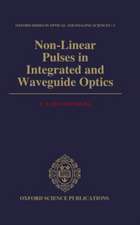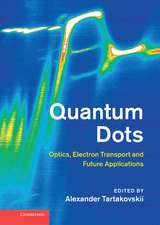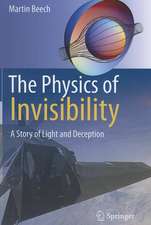Fundamentals of Quantum Optics and Quantum Information
Autor Peter Lambropoulos, David Petrosyanen Limba Engleză Hardback – 13 oct 2006
| Toate formatele și edițiile | Preț | Express |
|---|---|---|
| Paperback (1) | 390.63 lei 6-8 săpt. | |
| Springer Berlin, Heidelberg – 14 oct 2010 | 390.63 lei 6-8 săpt. | |
| Hardback (1) | 397.38 lei 6-8 săpt. | |
| Springer Berlin, Heidelberg – 13 oct 2006 | 397.38 lei 6-8 săpt. |
Preț: 397.38 lei
Nou
Puncte Express: 596
Preț estimativ în valută:
76.04€ • 79.60$ • 62.92£
76.04€ • 79.60$ • 62.92£
Carte tipărită la comandă
Livrare economică 05-19 aprilie
Preluare comenzi: 021 569.72.76
Specificații
ISBN-13: 9783540345718
ISBN-10: 354034571X
Pagini: 340
Ilustrații: XIV, 325 p. 95 illus.
Dimensiuni: 155 x 235 x 27 mm
Greutate: 0.64 kg
Ediția:2007
Editura: Springer Berlin, Heidelberg
Colecția Springer
Locul publicării:Berlin, Heidelberg, Germany
ISBN-10: 354034571X
Pagini: 340
Ilustrații: XIV, 325 p. 95 illus.
Dimensiuni: 155 x 235 x 27 mm
Greutate: 0.64 kg
Ediția:2007
Editura: Springer Berlin, Heidelberg
Colecția Springer
Locul publicării:Berlin, Heidelberg, Germany
Public țintă
GraduateCuprins
Quantum Optics.- Quantum Mechanical Background.- Quantum Theory of Radiation.- Atom in an External Radiation Field.- System-Reservoir Interaction.- Cavity Quantum Electrodynamics.- Field Propagation in Atomic Media.- Quantum Information.- Elements of Classical Computation.- Fundamentals of Quantum Information.- Principles of Quantum Computation.- Physical Implementations of Quantum Computation.
Notă biografică
Peter Lambropoulos, at present Professor of Physics at the University of Crete, received his PhD in 1965 from the University of Michigan (USA). Since then he has been visiting fellow at JILA, Univ. of Colorado (USA), has served as chair of the physics department at the University of Southern California, Head of the Theory group at the Max Planck Institute for Quantum Optics in Garching as well as director of the Institute of Electronic Structure and Lasers in Crete. The research in his groups over the last 25 years has spanned a broad area of laser physics, such as multiphoton and strong field processes, coherent control, cavity QED, quantum optics in photonic bandgap materials, with recent involvement in the theory of atom lasers and quantum dots. He is author or coauthor of about 250 papers as well as numerous chapters in volumes dealing with the above subfields. P. Lambropoulos is Fellow of the American Physical Society, Chair of the Board EGAS (European Group on Atomic Spectroscopy) of EPS.
David Petrosyan received his PhD in 1999 from the Institute for Physical Research, ANAS (Armenia). Since then he has been postdoctoral fellow at the Institute of Electronic Structure and Lasers (IESL) in Crete, Feinberg postdoctoral fellow at the Weizmann Institute of Science (Israel) and since 2002 is a member of the IESL. His research interests are centered around theoretical Laser Physics and Quantum Optics, such as coherent effects in multi-level atomic systems and cavity QED, as well as physical implementations of quantum computation and quantum communication schemes.
David Petrosyan received his PhD in 1999 from the Institute for Physical Research, ANAS (Armenia). Since then he has been postdoctoral fellow at the Institute of Electronic Structure and Lasers (IESL) in Crete, Feinberg postdoctoral fellow at the Weizmann Institute of Science (Israel) and since 2002 is a member of the IESL. His research interests are centered around theoretical Laser Physics and Quantum Optics, such as coherent effects in multi-level atomic systems and cavity QED, as well as physical implementations of quantum computation and quantum communication schemes.
Textul de pe ultima copertă
This book is an introduction to the two closely related subjects of quantum optics and quantum information. Essentially, the physical aspects of quantum information processing have now become an integral part of quantum optics. The book gives a simple, self-contained introduction to both subjects, while illustrating the physical principles of quantum information processing using quantum optical systems. It thus has an interdisciplinary character. For the benefit of a wider audience and to make the subject matter of the book accessible to those with backgrounds other than physics, the authors also include a brief review of quantum mechanics. Although much of the material used here can also be found in other books, discussed at various depths, the particular combination of the topics covered in this book is unique. Furthermore, some aspects of quantum information, for example those pertaining to recent experiments on cavity QED and quantum dots, are described here for the first time in book form.
Caracteristici
Clear introductory sections make this forefront topic accessible to non-specialists Brings together for the first time the important and mutually dependent fields of Quantum Optics and Quantum Information Provides a comprehensive overview suitable for both newcomers and seasoned quantum physicists Includes supplementary material: sn.pub/extras
















